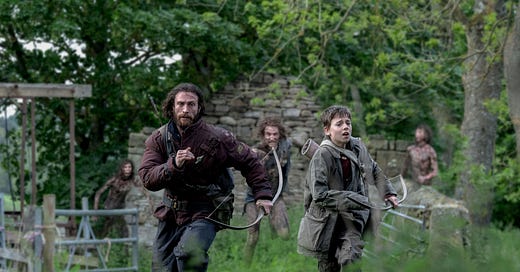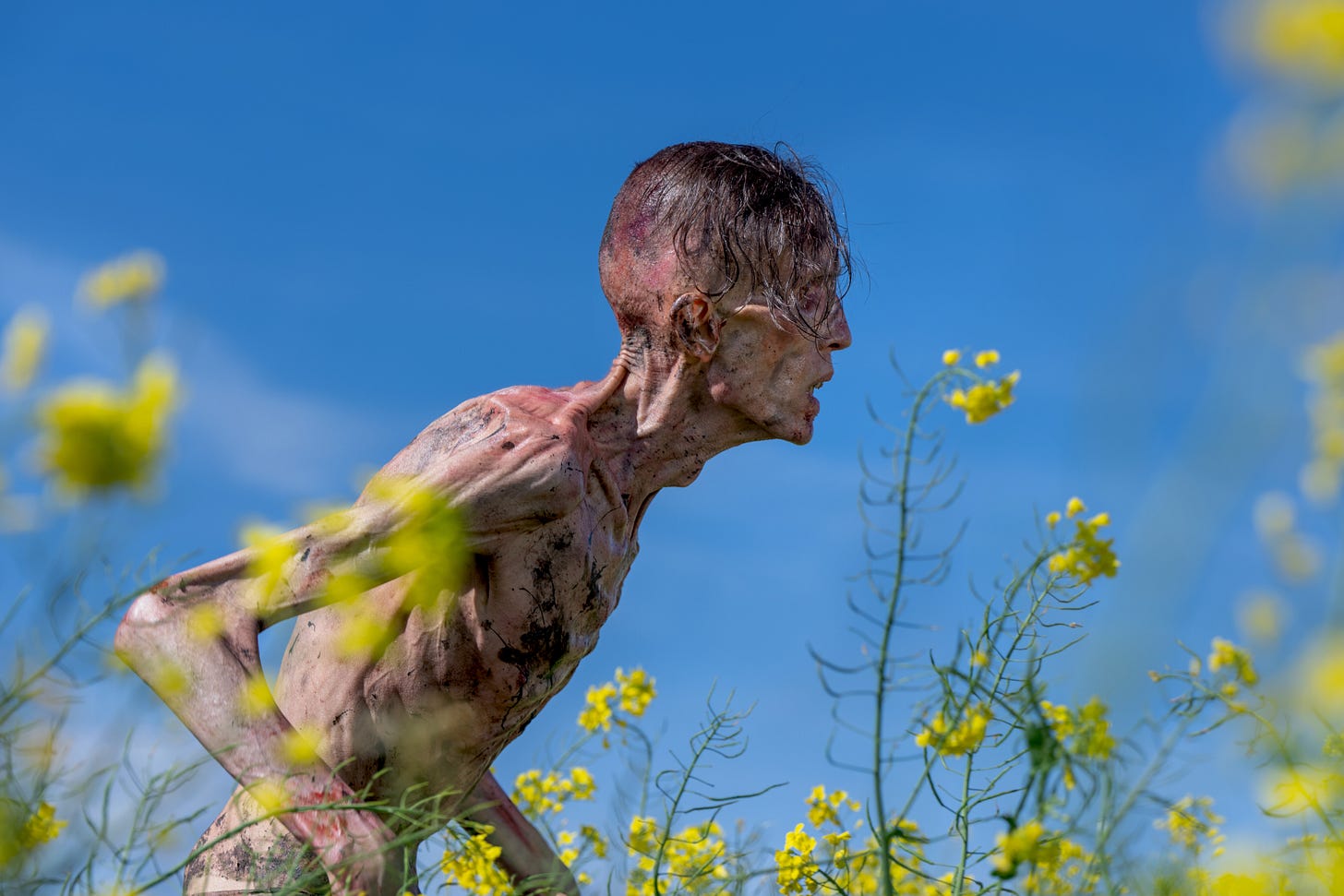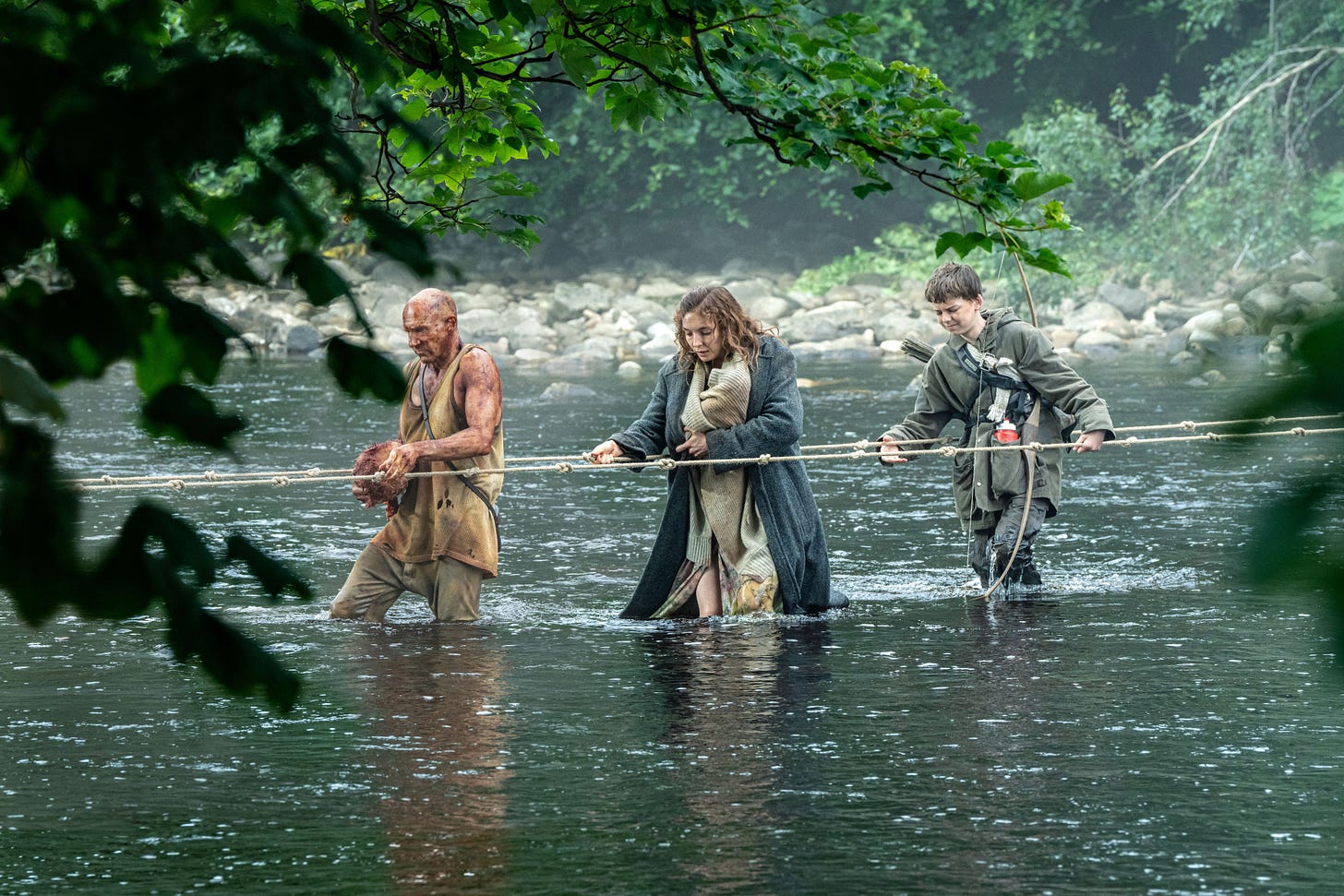Spoilers for 28 Years Later (2025)
Danny Boyle and Alex Garland returning to the apocalyptic world of 28 Days Later (2002) rightly resulted in significant hype, increasing again when it was announced that this would be followed by a fourth film in the series (The Bone Temple, written by Garland and directed by Nia DaCosta) with the option of a fifth film.
The original film used zombie tropes – despite the fact that the infected are never called zombies – to tell a larger story, about man’s capacity for violence, and what happens when the institutions that we rely on collapse around us. Jumping forward nearly three decades on from the outbreak, and largely ignoring the events of 28 Weeks Later (Juan Carlos Fresnadillo, 2007), Boyle and Garland showcase a UK where tribalism rules.
This is true both of the people, many of whom have found shelter on Holy Island, and the infected, who have banded together in packs led by oversized Alphas. The film hammers this point home, intercutting clips from Henry V (Laurence Olivier, 1944) with the children training to protect themselves from the infected.
That production on this film stretches back to the Brexit vote and our messy exit from the European Union shouldn’t be overlooked either, as Oliver’s Henry V explores the lead-up to the Battle of Agincourt, where the English took on French troops during the Hundred Years’ War.
At the start of the film, Spike (Alfie Williams) and his father Jamie (Aaron Taylor-Johnson) leave the island so that Spike can get his first zombie kill – a coming-of-age ritual in the wake of the outbreak. Here we see the first hints that some of the magic from that first film is gone. For starters, we get very little characterisation of Jamie, beyond the macho hunter-gatherer trying to toughen up his son.
Then there’s the editing. Whereas the first used early digital technology to create a kinetic, distorted cinematography. One that placed the viewer amid the chaos; 28 Years Later feels far too clean. This was shot on an iPhone 15 Max Pro, in 4K resolution and widescreen. Boyle would say in an interview with IGN during production that the widescreen ratio would force the audience to scan the frame. Instead, it emphasises how empty much of this film is.
This does have its benefits. Emptiness was used to great effect in the first film, but here it feels sterile. The insistence of smash cuts and fancy slow motion panning to follow Spike’s arrows into the neck of each zombie is fun the first time, but starts to highlight that this is style over substance.
After being chased home by an Alpha, Spike catches his father with another woman, while Isla (Jodie Comer) is ill at home. Infuriated by this and filled with tales about a doctor on the mainland who might be able to help his mother, Spike sneaks them both off the island. It’s here that we see some of the most interesting ideas of the film, and the biggest misses.
While the constant chase of the infected would have made 28 Years Later a poor imitation of the original, the section of Isla and Spike walking around the mainland means we must rely on the character development, of which there is little. As this is the start of a potential trilogy, it feels like Boyle and Garland opted to treat this as a brief introduction – fine in isolation, but a seriously unsatisfactory cinema experience.
Questions are raised. It’s shown that the infected have started to reproduce, and that the offspring may be immune to the virus. I say immune, because the baby is born covered in the mother’s blood, and even if the baby wasn’t infected in the womb, we know that it can pass through contact with the blood. Moments before this, Spike urgently wipes Isla’s face and tells her not to blink to stop the infection getting her.
We meet soldiers who are tasked with patrolling the coast to ensure that no one in the UK gets out and spreads the virus, yet with no hordes to speak of in the film, one wonders why other countries haven’t come ashore to eradicate the infected and start the rebuilding process.
The most interesting character we meet during this part of the film is Dr Ian Kelson (Ralph Fiennes). Fiennes is excellent, as is most of the cast, despite what little they have to work with, but he is present for far too little of the proceedings. He has stayed on the mainland to study the infected and dispose of the dead. He uses iodine – a seemingly infinite amount of it – to protect himself from the infection, though this is never explained fully, and can subdue the Alphas with a blowing dart of morphine.
While disappointment had set in by this point, there was a chance to develop some of the world here. To have Spike and Isla stay with Ian and move the film beyond zombie chases, and tackle the question of how to rebuild. Alas, this is rushed through, no doubt to be picked up again during The Bone Temple, and the film rushes to its climax.
It's at the climax where the wildest swing from the creators happens. A moment that seems to have fuelled much of the discourse around the film. Harking back to the admittedly tense prologue, a lone Spike is rescued by a group of tracksuit-wearing cult members, led by Jimmy (Jack O’Connell). They dispatch a group of zombies in such an over-the-top manner that it genuinely felt like a scene from Quentin Dupieux’s Power Ranger parody Smoking Causes Coughing (2022).
Jimmy’s group are also clearly dressed like Jimmy Saville, a nod to the cultural events that have not happened in the world of 28 Days Later. Saville died in 2011, and his horrendous crimes would not become public knowledge until after his death, so the characters in this universe would still see him as the eccentric presenter he was known as.
Audiences will no doubt cringe at this reveal, but it does give space for some interesting character work in later films, perhaps as the character’s own abuses are covered up or ignored. However, here, it feels jarring and out of place with the rest of the film. It’s another risk that isn’t given enough space to develop, leading to some intrigue about future films, but probably not enough to drive audiences back to the cinemas.
It's amazing to still have creators who take risks. In a marketplace that is saturated with easily pigeonholed films, Boyle and Garland have certainly made something unlike anything else available. There are touches of what George A. Romero would do with later films in his zombie series, incorporating broad humour and more ridiculous scenarios. Yet, Boyle and Garland appear to have focused so much on posing questions for the future films to answer that they have forgotten to make a satisfying movie to kick things off.
This is a heavily stylised, empty shell of a film. Much like the infected in the film, it’s moving at full speed to an end goal, with no thought to what happens in the interim.
Director: Danny Boyle
Writer: Alex Garland
Starring: Alfie Williams, Jodie Comer, Aaron Taylor-Johnson, Ralph Fiennes, Jack O'Connell











